|


FLOODS
GALORE
It
might seem incredible to some, that the UK Government know about the
worsening weather shift and have no plans in place to deal with it. Town
planners in Councils up and down the country are just as dense, making
no provision for the inevitable, as the global population continues to
rise sparking more CO2 and so more heavy rains and floods.
What
is needed is action right now to force Councils to approve plans for
housing stock that is flood resistant. Such designs exist today and
would save much of the heartache and worry associated with the pictures
and articles quoted on this website.
CHANGING
WEATHER PATTERNS - GUARDIAN February 2014
Forecasters warned of another bout of wet and stormy weather, amid predictions of further flooding chaos along the Thames and also further west in the Severn and Wye rivers.
There are 14 severe flood warnings still in place around the country, 12 around a fairly short stretch of the Thames and two in the long-drenched Somerset Levels, plus more than 350 lower-level flood warnings or alerts.
The Met Office said two fresh bands of heavy rain were heading for the UK. The first of these, arriving tomorrow, will pack winds that could hit 80mph in western coastal regions and 60mph inland.
"There could be some potential damage from that, particularly given it comes on the back of other storms recently," a Met Office spokeswoman said. The "quite vigorous" low-pressure front will bring widespread and intense downpours of up to 20mm, which could reach 30mm in some parts of the south and west. After a brief respite, another front is forecast to sweep across from the south from late on Friday, bringing similar amounts of rain and, further north, snow.
The gloomy forecast, following the wettest January for more than 200 years, saw the Environment Agency warn of yet more likely flooding on top of the estimated 1,000 properties inundated this week, about 800 along the Thames.
"Groundwater continues to be a problem, particularly across southern England," Kate Marks, a senior flood adviser for the Environment Agency, told a briefing.
Emergency services aided by the military would assist affected areas as much as possible, she added, saying that areas at risk included communities both along the Thames such as Windsor, Datchet and Egham, but also the Severn and Wye.
She said: "We are concerned about the River Severn and the River Wye in the south-west area. We have got a double pulse coming down the River Severn so we are seeing high levels in both Shrewsbury and Worcester."
The Somerset Levels, meanwhile, would take "weeks if not months" to drain to a safe working level, she warned, while the sheer amount of water on the ground could cause seepage flooding to homes in areas including Hampshire, Kent and parts of London.
Network Rail warned it would take weeks or even months to repair damage caused by wind, rain and floods in the south and west of England.
An estimated £100m of damage has been caused to the railway in the winter's storms so far. Around 4,000 railway staff have been deployed to tackle flood water and repair tracks to keep trains running.
Water levels are continuing to rise in the Thames Valley, where the track operator said nothing more could be done until floods recede. The army and emergency services have helped to shore up lines in the region, but flooding has continued to cause significant problems.
Passengers have been told to avoid travelling west out of London Paddington unless absolutely necessary, with First Great Western services to Cornwall affected by the elements.
Some trains are running through the flooded Thames Valley, but speed restrictions mean limited services can run.
Network Rail's director of operations, Robin Gisby, is quoted as saying: "We're aware of structures and embankments that are susceptible in poor weather conditions. During a normal winter we'd be keeping an eye on about a dozen. Currently we're monitoring about 400."More money was made available for the railway in the next five-year plan specifically to combat the challenges of the climate. The Office of Rail Regulation agreed an extra £300m that Network Rail requested in its strategic review for resilience, to take account of the more extreme weather conditions that the UK is now experiencing. Last year, chief executive David Higgins warned that the changing weather was "a wake up call for the whole industry, which we ignore at our peril".
With flooding in the Somerset Levels leaving one stretch of the line under water for three-quarters of a mile, rail services to south-west England via Bristol now terminate at Weston-super-Mare, with a limited service extending to Bridgwater. Coaches are replacing trains between Bridgwater and Taunton, and between Plymouth, Exeter and Bristol.

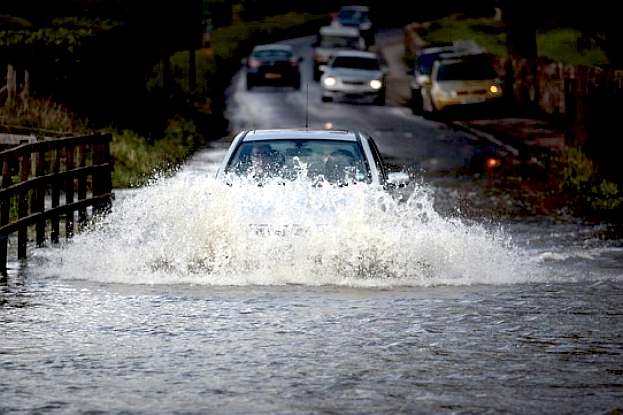
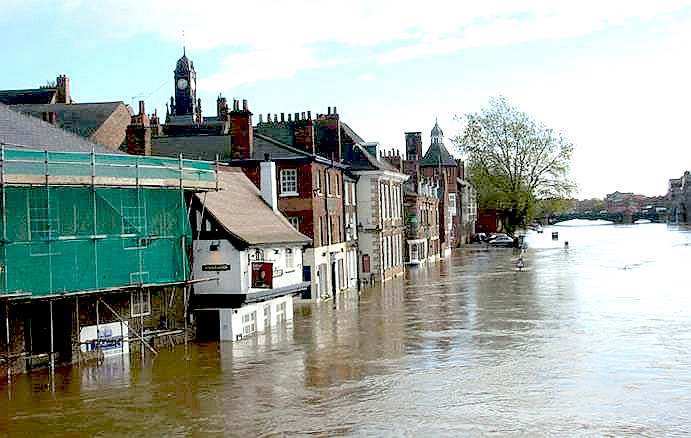
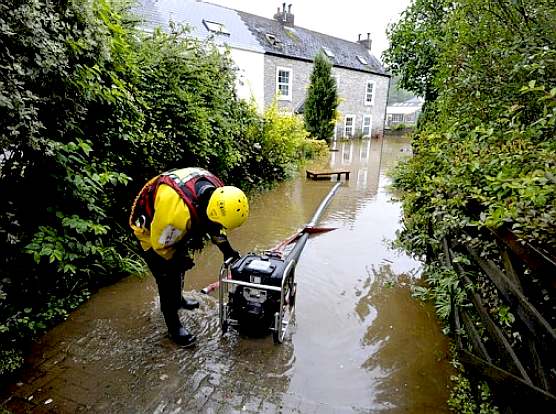
CHERRY
FLOOD RESISTANT CONCEPT - FLATPACK MOBILE HOMES:
The
Utopia Tristar formula includes treated timbers as standard, and that
means immersion in water will not fundamentally undermine structural
integrity should one of our homes with the Flood/Tsunami resistant
option, encounter adverse weather conditions.
The
method of construction allows for sealed buoyancy compartments, which
when coupled with our heat storage system using water ballast will keep
a unit afloat with a high degree of stability. These homes may be
ordered as mobile units, so are free to move or be moved - in this case
by high volume flood waters. The survivability of such freak weather
conditions is high, thus the concept has enhanced sustainability in
geographically prone flood areas. After a flood, or a catastrophe such a
a tsunami, the home may need to be re-sited, but it would survive intact
- you would not lose your dwelling; you'd not lose your investment.
We
are due to conduct tank and other tests in the coming year, the results
of which will be reported on this site.
The
system could free up thousands of acres of low level land in India, the
UK and USA, where at the moment it would be folly to allow the building
of conventional houses. See the flood sequence at the foot of this page.
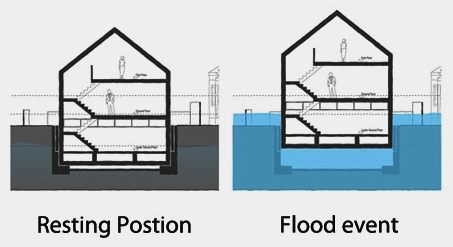
Another
flood resistant concept -not ideal for tsumanis
CONVENTIONAL
FLOOD RESISTANCE THINKING:
What is it?
Building resistance is the process of making a building resistant to flood damage, either by taking the building out of contact with floodwaters or by making the building resistant to any potential damage resulting from contact with floodwaters. This process involves the construction of a building in such a way to prevent floodwater entering the building and damaging its fabric and allow flood victims some degree of protection from flooding. These measures can prevent water getting into a property, particularly for shallower floods or allow time for the householder to move valuable possessions upstairs.
Why use it?
Floodwater can be disruptive and can cause structural and cosmetic damage to a building, which can be expensive to repair. Floodwater can also carry contaminants creating additional health risks. With low flood depths it may be possible to prevent significant damage to a building and may allow continued use of a building during a flood. It may also be beneficial to install some flood resistant measures to properties located behind flood defences, to protect them in the event that the defences are overtopped or fail.
When to use it?
Ideally buildings should be placed so as to avoid flood-risk. However, when it is not possible to do so, such as if the building already exists or it replaces an existing building then measures to reduce the effects of flooding must be considered. Typically resistance measures may be used when the flood depth is less than 600mm but subject to the characteristics of the flood such as speed and debris. Consideration should be given to the effect that climate change may have on the potential depth of flooding. In some locations, buildings not currently at risk of flooding, maybe in the future.
KEY QUESTIONS
* What measures are available to help families build up their own levels of flood resilience?
* How do humans adapt to risk?
KEY
CONCEPTS
* Place
* Environmental interaction
* Human processes
* Physical processes
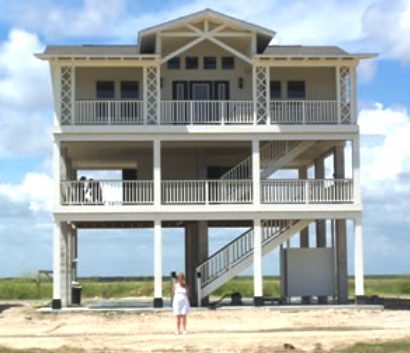
This
house of stilts stands a good chance of surviving floods & tsunamis
What measures are available to help families build up their own levels of flood resilience?
Measures can be used to make your home both resistant and resilient to flooding. Flood resistance measures add extra protection, preventing water from entering the home. Products for flood resistance include:
* Pump and sump systems, which pump out water entering the house from the ground
* Flood skirts or barriers, which protect any possible inlet for water,for example windows and doors, and are drawn into
position when there's a threat of flooding
* One-way valves, which prevent water backing up into the property from water outlet pipes
* Water resistant sealants, which are used around windows and doors and on porous materials such as bricks and water
Measures to make your house more flood resilient, on the other hand, aim to minimise the damage caused by flood
water. These include:
* Replacing perishable materials, for example replacing chipboard floors for concrete and swapping carpet for tiles
* Moving expensive electrical equipment out of the way, for example putting your boiler upstairs
* Raising electrical points above likely flood levels
* Replacing chipboard with plastic, for example fixtures and fittings in the kitchen and bathroom
* Replacing wooden frames and skirting boards with plastic alternatives
* Raising floor levels - of course this is not always possible
* Replacing insulation from mineral to cell
* Protecting joists with a chemical damp proof course
Families who live in flood risk areas should also consider preparing a flood kit. This should include the following items:
* Important documents, such as passports and insurance certificates, which can be expensive to replace
* A torch, in case the flood occurs at night and the power is affected
* A battery or wind-up radio to listen for important information
* A mobile phone to call for help
* Waterproof clothing, for example wellies and rubber gloves in case you have to enter the flood water
* A first aid kit to attend to any minor injuries
* Blankets to keep you warm if your heating has to be switched off
* Bottled water, as tap water won't be drinkable after a flood
* Non-perishable items of food in case you are not able to be rescued for several hours


Forget
conventional houses: Left is a floating dock dwelling concept, right a
floating house scheme
HOW
DO HUMAN ADAPT TO RISK?
Other natural hazards include:
Volcanoes: can kill when they explode or through lava, pyroclastic flows, hot ash and poisonous gases. People often live near volcanoes due to the fertile soils found there, creating a hazard risk. Areas affected include South America's west coast
Hurricanes: can kill when strong winds destroy buildings and blow down trees and structures. They develop offshore in warm ocean regions. Areas affected by hurricanes are highly populated due to their location and climate, creating a hazard risk. Areas affected include the Caribbean and Florida
Droughts: can kill when water supplies are low, when crops fail, when fires start and when temperatures become too high for sick and elderly people. Many parts of the world experience droughts regularly or occasionally. A lot of these places, for example the Mediterranean and California are densely populated, creating a hazard risk
Earthquakes: can kill when buildings and other structures collapse. They mostly take place close to plate boundaries. Many coasts are plate boundaries and people are attracted to coasts to live, creating a hazard risk. Cities like Tokyo, Istanbul and Los Angeles are affected
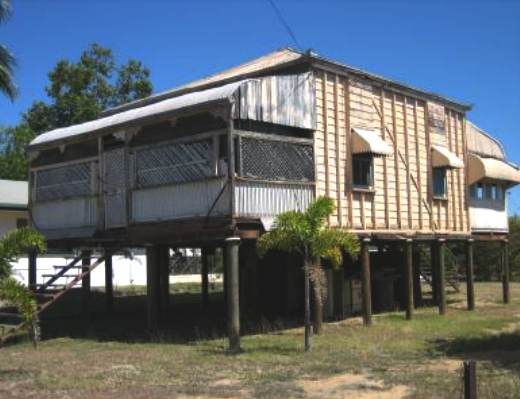

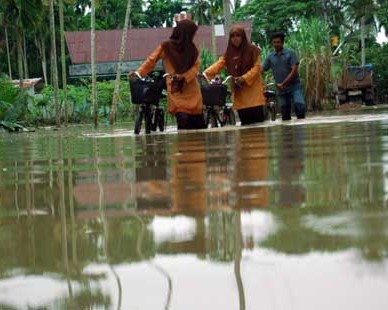

KEY CONSIDERATIONS
1. New buildings should be located out of flood-risk where possible.
2. Flood resistance typically requires human intervention to implement actions to protect the building, this means that ample warning time needs to be available to set up defences.
3. Consider how waterproof the building fabric is (type of frame, type of infill panels, floors, walls…).
4. Floodwater can rise up from the ground, not just enter through doors, windows or other openings.
5. It is necessary to determine the structural integrity of the building, deep water can cause structural damage.
6. Use certified waterproof sealants and materials to dry proof the building.
7.
Consider pipes in and out of the building as potential paths for water.
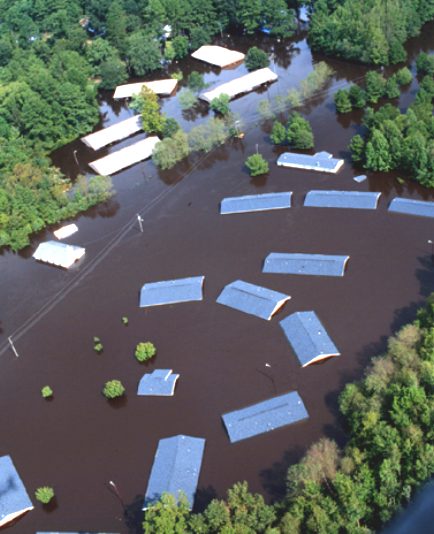
HURRICANE
FACTS
The United States has a significant hurricane problem. More than 60% of
the Nation’s population live in coastal states from Maine to Texas, Hawaii, and Puerto Rico.
Hurricane Floyd (1999) brought intense rains and record flooding to the Eastern U.S. Of the 56 people who perished, 50 drowned due to inland flooding.
Tropical Storm Alberto (1994) drifted over the Southeast United States and produced torrential rainfall. More than 21 inches of rain fell at Americus, Georgia. Thirty-three people drowned. Damages exceeded $750 million.
Tropical Storm Claudette (1979) brought 45 inches of rain to an area near Alvin, Texas, contributing to more than $600 million in damages.
Hurricane Agnes (1972) produced floods in the Northeast United States which contributed to 122 deaths and $6.4 billion in damages. Long after the winds from Hurricane Diane (1955) subsided, the storm brought inland flooding to Pennsylvania, New York, and New England contributing to nearly 200 deaths and $4.2 billion in damages.
So, the next time you hear a hurricane warning - it may be too late for
you. Think inland flooding today and call Utopia Tristar Partners.
FLOOD
SEQUENCE 
Moderate
flood - no dynamic effect on house, where special design has the
building raised 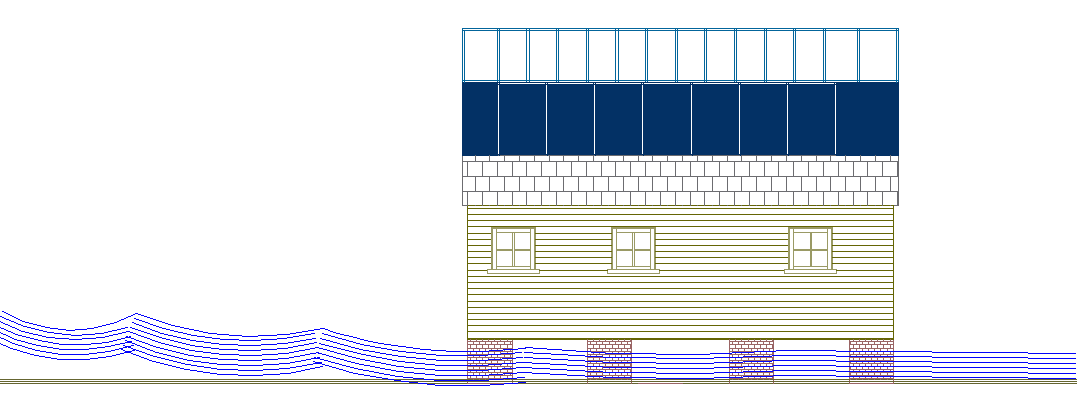
Deep
flood - still no dynamic reaction to the house 
Serious
flooding - begins to affect house dynamically causing lift 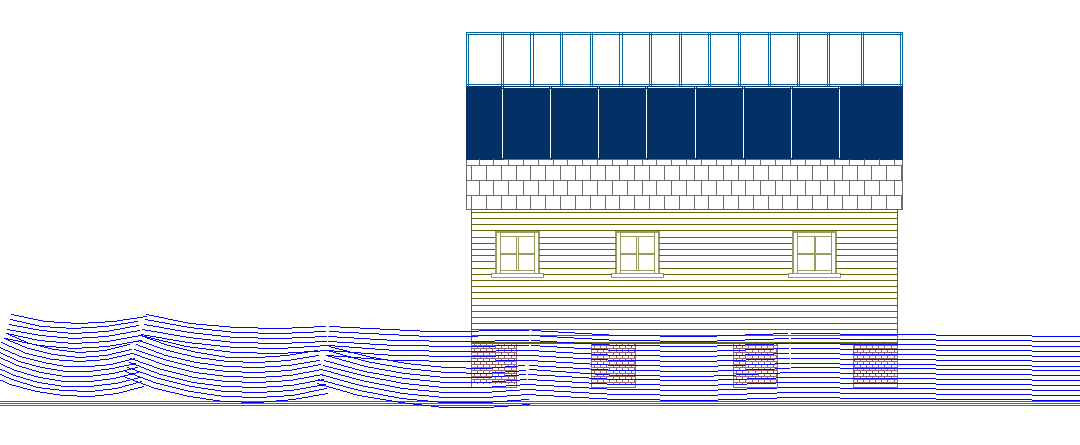
High
floodwater - the house lifts off the ground and floats until the
floodwater subsides. A special tethering systems absorbs shock and
returns the building to its original location. The building is
waterproof, so will be undamaged after the flood, with all contents kept
dry and safe. If you are planning living in an area subject to seasonal
storms, why even consider any other type of home.
LINKS
http://www.news24.com/SouthAfrica/News/Heavy-rains-cause-countrywide-havoc-20140311
http://www.theguardian.com/environment/2014/feb/11/uk-flooding-met-forecast-rains
http://www.disastercenter.com/guide/tsunami.html
http://www.independent.co.uk/flooding-and-landslides-after-himalayan-tsunami-hits-india
http://edition.cnn.com/2013/06/20/world/asia/india-floods
http://rt.com/news/toll-dead-region-floods-633/
http://www.huffingtonpost.ca/2012/11/04/tsunami-flooding-storm-surge-vancouver-richmond-earthquake
http://www.dailymail.co.uk/news/article-2174353/Japan-floods-2012
http://www.nws.noaa.gov/oh/hurricane/inland_flooding.html
http://www.weather.gov/
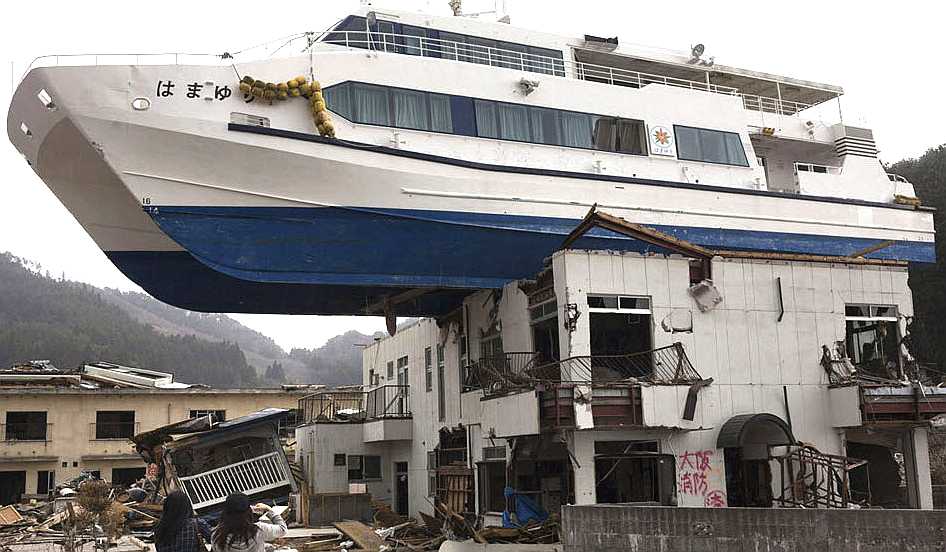
NOAH'S
ARK - We're
not sure if this is a boat-house, or a house-boat. Either way the
picture illustrates the dangers of flooding caused by tsunami like
conditions. These super strength concrete buildings in Japan, that were
built to withstand earthquakes, have remained standing. Equally, the
catamaran as a floating structure has survived intact. If the boat had
been a tethered tsunami resistant building, it would not have been
carried along and deposited on top of these houses. The tethering system
would have absorbed the impact of the tidal wave, and slowly draw the
house back to its original location as the flood waters abated, so that
with some minor adjustment, it could have been re-positioned in exactly
the position it started.
|



















